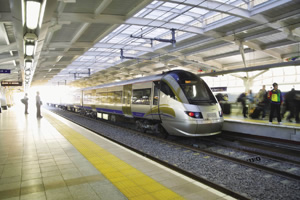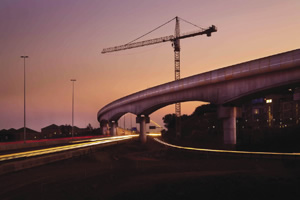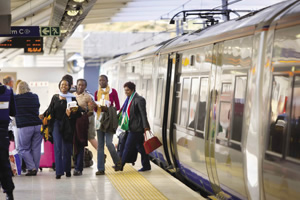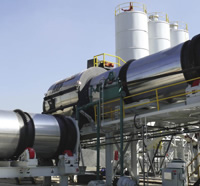|
SEPTEMBER 2010 |
 |
|
 |
| Home | | |
Message from CE | | |
Cover story | | |
Building SA | | |
| |
Operations | | |
Historic Projects | | |
Sustainability | | |
| Currently viewing: Bulding SA/ Next: News |
Building SA
Murray & Roberts has a leading role in a range of projects to upgrade South Africa's road, rail and power networks. Robust explores the Group's significant contribution to the development of world class social infrastructure.
Gautrain
 |
 |
 |
“On 8 June 2010, Phase 1 of the Gautrain System was opened for commercial service. This was truly a world class achievement and took place 19 days ahead of the initial contractual completion date of 27 June 2010,” according to the Gautrain web site.
“The first phase operations include the airport train service between Sandton Station and OR Tambo International Airport, a commuter service between Sandton and Rhodesfield – with an intermediate stop at Marlboro Station – as well as dedicated feeder and distribution bus services to and from the Sandton and Rhodesfield Stations. The Operations Control Centre, together with the Train and Bus Depot facilities located just south of Allandale Road in the Midrand area, were also completed as part of the first phase scope of works.”
 |
| Jerome Govender, Project CEO |
This sparse announcement scarcely does justice to the monumental effort that went into commencing operations ahead of the 2010 Soccer World Cup to accommodate the tens of thousands of foreign visitors who used this facility as their first introduction to South Africa.
Commenting on the achievement, Murray & Roberts CE Brian Bruce said: “Gautrain was never contractually bound to the World Cup, and the complexity of the contract negotiations pushed the end date of the contract beyond the tournament. However, it became informally associated with the World Cup and a decision was taken to accommodate two deliverable dates – one for the OR Tambo-Sandton route and one for the rest of the network.”
In the end it took a ‘Herculean’ effort to achieve the opening ahead of the World Cup.
Murray & Roberts and its partners pulled out all the stops to achieve the success sought by a government eager to host a memorable tournament and to encourage more public private partnership (PPP). The first major milestone of the country’s biggest ever PPP simply had to be an outstanding success.
And it was. “It seemed an impossible task but we achieved it by the thinnest of margins, the last contractor left the site of Sandton Station at 4am on 8 June and the first train left the station – on time – 90 minutes later,” says Brian.
Since then, Gautrain has exceeded expectations, running well over budgeted passenger volumes, and impressing all with its efficiency and world class quality.
Cape Town Stadium
Construction of the 68 000 seat Cape Town Stadium commenced in March 2007 and in just 33 months was completed, on deadline, by Murray & Roberts and its partner. The stadium was handed over to the City of Cape Town on 21 December 2009 and it successfully hosted nine World Cup matches, including a semi-final.
 |
| Andy Fanton, Project manager |

The Cape Town Stadium is located on Green Point Common close to the V&A Waterfront and Cape Town city centre. The stadium is 55 metres high with a fabric façade and a steel cable tensioned glazed roof. Approximately 10 500 people were involved in its construction and it will have a positive impact on communities and economic growth in the Western Cape Province for years to come.
Upgrading major freeways
 The Gauteng Freeway Improvement Project (GFIP) has been implemented to upgrade and expand the freeway network to significantly reduce traffic congestion and unblock access to economic opportunities and social development projects. The GFIP will inject approximately R29 billion into the South African economy and approximately R13 billion into the provisional gross geographic product, creating nearly 30 000 direct jobs over its life cycle.
The Gauteng Freeway Improvement Project (GFIP) has been implemented to upgrade and expand the freeway network to significantly reduce traffic congestion and unblock access to economic opportunities and social development projects. The GFIP will inject approximately R29 billion into the South African economy and approximately R13 billion into the provisional gross geographic product, creating nearly 30 000 direct jobs over its life cycle.
 |
| Phillip Hechter, MD: Much Asphalt |
In anticipation of this development, Murray & Roberts company, Much Asphalt upgraded its facilities and capacity and was contracted in 2009 to supply 70% of the asphalt required to complete the first phase of the GFIP.
Phase 1 is due for completion in September 2010. The initiative that crosses the Johannesburg, Ekurhuleni and Tshwane metropolitan boundaries widens freeways to at least four lanes in both directions and in some sections up to six lanes. This phase of the project will upgrade 185 kilometres of the existing freeway network. Over the lifespan of the project, a further 376 kilometres of upgraded and newly constructed freeways are planned for implementation. The network will provide an interconnected freeway system of inner and outer ring roads, incorporating the historically-neglected western and southern Gauteng settlements.
The most significant contribution the investment will make to ordinary citizens is the quality of life improvement that an upgraded road infrastructure will deliver.

